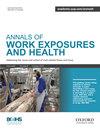160 Performance improvement of beta gauge particulate monitors
IF 1.8
4区 医学
Q3 PUBLIC, ENVIRONMENTAL & OCCUPATIONAL HEALTH
引用次数: 0
Abstract
The Beta gauge is used in PM monitoring. It measures particle mass by utilizing beta attenuation. However, due to the high deviation of beta particles per second, commercial beta gauges have a high response time. That means achieving real-time monitoring is challenging. This study aims to improve the beta gauge’s detection limit(LOD) and response time(TR) for real-time monitoring. To reduce external environmental interference, aerosol generation system was established in laboratory to generate stable challenge particle size and distribution. The commercial beta gauge was used to evaluate the effects of the sampling area, sampling number, and smoothing time(TS). Lambert Beer’s law was used to convert the beta intensity into mass concentration per second, evaluating the beta gauge’s TR, S/N ratio, and LOD. By adjusting TS from 5 to 75 min, TR reaches from 0.3 to 60 minutes. At daily average PM2.5 of 35 μg/m3, the SD of readings decreases from 175 to 3.2 μg/m3. At quantitative standard (S/N ratio=10), when the sampling area is reduced from 2 to 0.4 cm2, the required TS is shortened by 33%. When the sample number is increased to 6, the required TS can be shortened by 60%. The LOD is about 12 μg/m3 with TS of 75 minutes. By increasing the sample number to 6, it can be achieved 1.5 μg/m3. To optimize its response time, the smoothing method can be utilized. To improve the stability of beta gauge measurement and achieve a lower LOD, it is recommended to reduce the sampling area and increase the number of samples.160 β 测量仪微粒监测器的性能改进
贝塔仪用于 PM 监测。它利用贝塔衰减来测量粒子质量。然而,由于每秒β粒子的偏差较大,商用β测量仪的响应时间较长。这意味着实现实时监测具有挑战性。本研究旨在提高贝塔仪的检测限(LOD)和响应时间(TR),以实现实时监测。为减少外部环境干扰,在实验室建立了气溶胶生成系统,以生成稳定的挑战粒度和分布。使用商用 beta 测量仪来评估采样区域、采样次数和平滑时间(TS)的影响。使用兰伯特-比尔定律将β强度转换为每秒的质量浓度,评估β测定仪的TR、信噪比和LOD。通过将 TS 调整为 5 至 75 分钟,TR 达到 0.3 至 60 分钟。当 PM2.5 的日平均值为 35 μg/m3 时,读数的 SD 值从 175 μg/m3 降至 3.2 μg/m3。在定量标准(信噪比=10)下,当采样面积从 2 平方厘米减少到 0.4 平方厘米时,所需的 TS 缩短了 33%。当样品数量增加到 6 个时,所需的 TS 可缩短 60%。当 TS 为 75 分钟时,LOD 约为 12 μg/m3。将样品数增加到 6 个后,可达到 1.5 μg/m3。为了优化响应时间,可以使用平滑法。为提高贝塔测量仪测量的稳定性并降低 LOD,建议缩小采样区域并增加采样数量。
本文章由计算机程序翻译,如有差异,请以英文原文为准。
求助全文
约1分钟内获得全文
求助全文
来源期刊

Annals Of Work Exposures and Health
Medicine-Public Health, Environmental and Occupational Health
CiteScore
4.60
自引率
19.20%
发文量
79
期刊介绍:
About the Journal
Annals of Work Exposures and Health is dedicated to presenting advances in exposure science supporting the recognition, quantification, and control of exposures at work, and epidemiological studies on their effects on human health and well-being. A key question we apply to submission is, "Is this paper going to help readers better understand, quantify, and control conditions at work that adversely or positively affect health and well-being?"
We are interested in high quality scientific research addressing:
the quantification of work exposures, including chemical, biological, physical, biomechanical, and psychosocial, and the elements of work organization giving rise to such exposures;
the relationship between these exposures and the acute and chronic health consequences for those exposed and their families and communities;
populations at special risk of work-related exposures including women, under-represented minorities, immigrants, and other vulnerable groups such as temporary, contingent and informal sector workers;
the effectiveness of interventions addressing exposure and risk including production technologies, work process engineering, and personal protective systems;
policies and management approaches to reduce risk and improve health and well-being among workers, their families or communities;
methodologies and mechanisms that underlie the quantification and/or control of exposure and risk.
There is heavy pressure on space in the journal, and the above interests mean that we do not usually publish papers that simply report local conditions without generalizable results. We are also unlikely to publish reports on human health and well-being without information on the work exposure characteristics giving rise to the effects. We particularly welcome contributions from scientists based in, or addressing conditions in, developing economies that fall within the above scope.
 求助内容:
求助内容: 应助结果提醒方式:
应助结果提醒方式:


